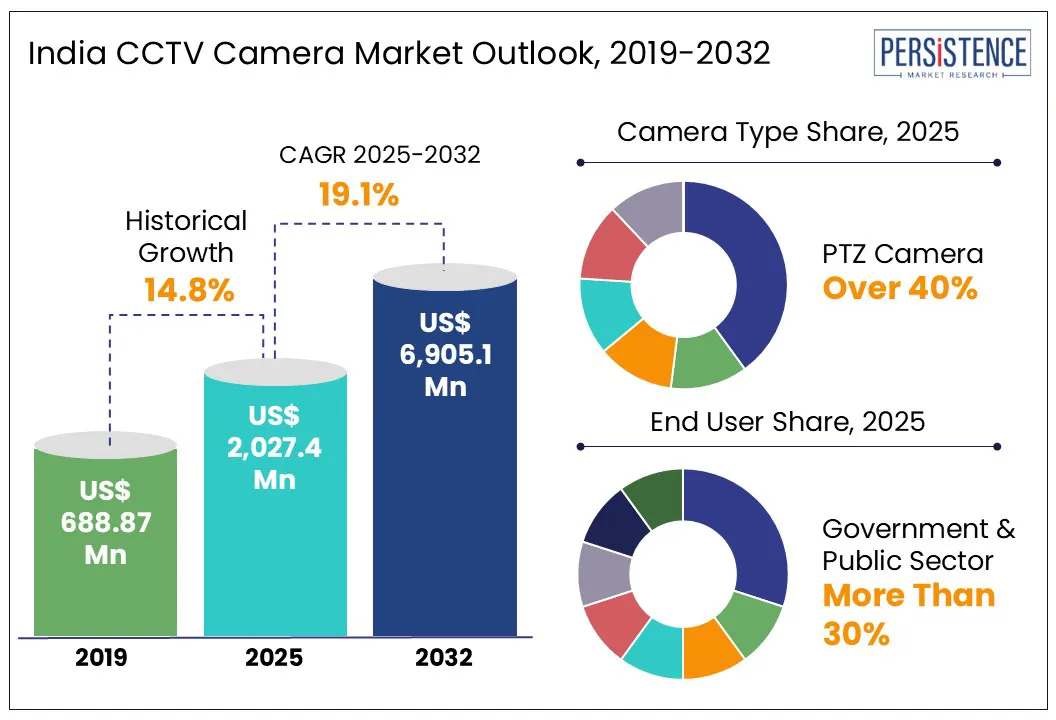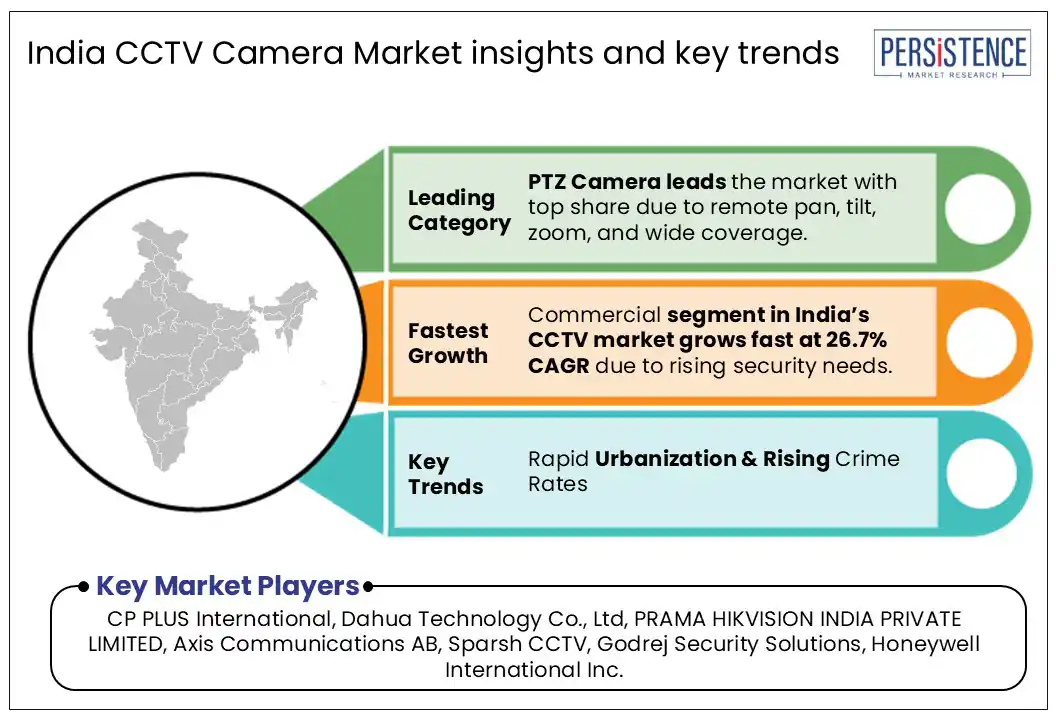ID: PMRREP33502| 150 Pages | 24 Jun 2025 | Format: PDF, Excel, PPT* | Semiconductor Electronics

According to Persistence Market Research, the CCTV camera market size in India is estimated at US$ 2,027.4 Mn in 2025. Looking ahead, from 2025 to 2032, CCTV camera sales in the country are projected to surge ahead at 19.1% CAGR and reach US$ 6,905.1 Mn by 2032-end.
The Indian manufacturing ecosystem is changing dramatically with a shift towards local production. In the wake of the government's Make in India and Atmanirbhar Bharat, manufacturers are establishing production units in the country. This move is driven by the need to minimize reliance on imports from nations that are under geopolitical scrutiny. With growing localization among manufacturers, there is also a movement towards developing India-centric designs that are affordable and according to the requirements of local environmental conditions.
The STQC (Standardization Testing and Quality Certification) mandate in India, in force since June 6, 2024, and effective on all CCTV cameras including general market sales from April 9, 2025, requires devices to adhere to tight cybersecurity, hardware integrity, and encryption standards. This regulation bars non-certified models from government tenders, from general distribution, boosting Indian brands like Sparsh and CPPLUS, which report increased contracts and market recognition. MSME manufacturers face steep hurdles testing fees, technical demands, and tight deadlines, risking consolidation in the market.

|
Attribute |
Key Insights |
|
India CCTV Camera Market Size (2025) |
US$ 2,027.4 Mn |
|
Projected Market Value (2032) |
US$ 6,905.1 Mn |
|
Market Growth Rate (2025 to 2032) |
19.1% |
|
Historical Market Growth Rate (CAGR 2019 to 2024) |
14.8% |
India's urbanization is playing a major role in augmenting demand for CCTV cameras. It is estimated that by 2031, 600 million people will reside in towns and cities, or nearly 40% of the country's population, a phenomenal increase from 31% in 2011. Urbanization is putting tremendous pressure on city infrastructure, housing, traffic infrastructure, and public security. In a battle to respond to these issues, Urban Local Bodies (ULBs) and municipal corporations are adopting CCTV surveillance as a major part of their urban planning policy. In the majority of cities nowadays, the deployment of CCTV cameras at public places such as markets, traffic junctions, bus and railway stations, and government offices is obligatory as a measure to enhance real-time
The increasing fear of urban crime, whether it is theft, vandalism, or a terror threat, is fueling demand. Even those cities that are highly monitored by CCTV cameras like Delhi, Hyderabad, Chennai, and Indore also continue to record high crime rates. India recorded more than 5.8 million cognizable crimes in 2023, with a rate of crime of approximately 422 cases for every 100,000 people, according to the National Crime Records Bureau (NCRB). The country's crime index stands at 44.43, which places it at number 71 in the world, and its homicide rate is 3.08 per 100,000, which is number 95 in the world. Delhi accounted for almost 30% of all Indian Penal Code (IPC) offenses from 19 metro cities, which clearly indicates how much it has become essential to tighten surveillance systems in cities.
The growth in infrastructure projects in India has increased the demand for CCTV cameras substantially, fueled by the government's efforts to strengthen urban security and pursue smart city programs. The Smart Cities Mission, initiated in 2015, is designed to build cities with upgraded infrastructure and services, including smart surveillance systems. As of 2024, more than 84,000 CCTV cameras have been installed across 100 smart cities, boosting urban security and monitoring. In Delhi, the Public Works Department aimed to install 280,000 CCTV cameras throughout the city. In December 2023, over 246,000 cameras have been installed, reaching 88% of the target. The large network of surveillance assists law enforcement by preventing and detecting crime, keeping tabs on suspicious persons and vehicles, and helping to solve cases.
The increasing focus on urban mobility and public security has resulted in the construction of more than 2,500 km of smart roads with universal access, utility conduits, and adequate signage in 100 smart cities. Smart roads have been fitted with surveillance mechanisms, such as CCTV cameras, to track and control urban mobility, adding to the greater demand for such equipment. India's infrastructure industry is poised for strong growth, with investments of US$ 1.4 trillion earmarked over the period until 2025. For example, in March 2024, the Minister of Civil Aviation and Steel declared the opening of 15 airport projects with a budget of US$ 12.1 billion, to be finished by 2028.
In 2024, the Indian government implemented several strategic policies to enhance the quality and cybersecurity of CCTV systems, creating growth opportunities for domestic manufacturers. In March 2024, the Ministry of Electronics and Information Technology (MeitY) introduced the Public Procurement Preference under the Make in India initiative, specifically targeting CCTV and video surveillance systems. This policy required CCTV devices to meet Essential Requirements (ER), including mandatory certification by the Bureau of Indian Standards (BIS), ensuring high-quality and secure systems for public and private sector use.
Further strengthening the regulatory framework, MeitY updated the Comprehensive Regulatory Order (CRO) in October 2024, mandating robust cybersecurity features such as physical security controls, access management, network encryption, and penetration testing for all CCTV cameras made or sold in India. Under Section 79A of the Information Technology Act 2000, 15 forensic laboratories were designated as Examiners of Electronic Evidence, with the STQC Directorate overseeing their certification. These coordinated efforts have built a strong ecosystem for secure, high-quality CCTV deployment, significantly driving the growth of the market.
The Indian market faces significant restraints due to the cost of installation, mostly affecting small businesses and consumers. The initial investment is between US$17 and US$208 per camera, depending on the type of camera, number, recording equipment, and complexity of the installation. Wireless cameras, while easier and less expensive to install, are more expensive in hardware. Installation services by a professional are charged between an additional US$6 to US$23 per camera, with DVRs/NVRs ranging between US$35 to US$200, and cabling being an additional US$22 to US$55.
Maintenance is needed for reliability in the system, but annual maintenance contracts, or AMCs, cost between US$24 and US$58 a year, which includes cleaning, upgrading, and small repairs. Without maintenance, the system malfunctions, and surveillance effectiveness is decreased. Large government projects can absorb the cost, but household and small business budgets tend to find them beyond their means, restricting widespread adoption and leaving many regions with insufficient surveillance coverage due to the lack of funds.
“AI-Powered Video Analytics Transforming CCTV Footage into Actionable Big Data in India”
AI implementation is rapidly revolutionizing CCTV surveillance in India, making intelligent analytics possible for public safety and smart city management. Indian Railways has implemented facial recognition technology in over 500 stations to track passenger movement, while Staqu Technologies' JARVIS platform processes live feeds from over 700 cameras in 70+ Uttar Pradesh jails to detect scuffles and monitor inmates' activities. State police units are also implementing AI-based CCTV systems to control sensitive zones amidst mass events.
Surveillance systems developed by organizations such as Trueview now incorporate real-time alerts, crowd management, and behavioral analysis to support smart city projects. AI-powered traffic monitoring systems are in place in cities such as Pune and Bengaluru, facilitating traffic regulation and urban mobility. During the Maha Kumbh Mela 2025 in Prayagraj, around 2,700 AI-enabled cameras were keeping an eye on over 400 million visitors, while the Ahmedabad and Pune authorities are using similar systems to manage crowds at big festivals as well as monitor safety on public buses.
“High Adoption of PTZ Cameras Driven by Multi-Directional Coverage and Cost Efficiency in Large-Area Surveillance”
PTZ cameras hold a dominant market share of more than 40% in 2024. PTZ cameras are able to pan (shift horizontally), tilt (shift vertically), and zoom in and out, enabling real-time, dynamic surveillance with their 360-degree pan and high optical zoom. This multi-directional capability minimizes the number of cameras needed to cover large areas such as parking lots, stadiums, city crossroads, and airports. For instance, a PTZ camera can substitute for 3-4 fixed cameras, and because of that, they are very cost-efficient for operators, even though their initial cost is higher. This efficiency in operations plays an important role in their popularity.
Dome cameras are likely to increase at a high rate because they are versatile, unobtrusive, and appropriate for both indoor and outdoor monitoring. Dome cameras usually have a casing to shield them from tampering or physical attacks. The greater demand for rugged, tamper-resistant security measures makes dome cameras the best option for such high-risk installations. The government’s push towards smart urban infrastructure has created substantial demand for compact and visually non-intrusive cameras that can be easily integrated with advanced monitoring systems. For instance, Pune, Surat, and Bhopal are all widely employing dome cameras for traffic monitoring, surveillance in public areas, and preventing crime.
“Public Safety, Crime Prevention, and Infrastructure Protection Propel CCTV Adoption”
The government and public sector are projected to maintain a leading market share, fueled by the nation's increasing emphasis on public security, crime prevention, smart city initiatives, and protection of critical infrastructure. India's urbanization is at a rapid pace, backed by fears of crime levels in populated cities, which has led authorities to increase video surveillance networks across public areas like markets, traffic intersections, parks, railway stations, airports, and metro stations. The roll-out of government-led projects like the Smart Cities Mission, Safe City Projects, and Digital India. For instance, under the Smart Cities Mission, the government of India has envisioned creating over 100 smart cities with interconnected surveillance systems. Delhi alone had more than 3 lakh CCTV cameras installed by the government by early 2024, which is a major demand driver in this space.
The commercial segment is expected to emerge fastest in the next few years on account of a mix of policy push, quick infrastructure development, and rising security concerns in various sectors. The hospitality sector is growing quickly, particularly with the growth of tourism and business travel in India. Hotels, restaurants, resorts, and convention centers are substantially boosting their expenditure on CCTV camera installations to create a more secure environment for guests, deter property damage, and make themselves compliant with local safety norms.

The Indian CCTV camera market is consolidated. Manufacturers are starting to incorporate AI and edge computing into the mid-range CCTV cameras, offering features such as facial recognition, number plate recognition, and smart motion sensing. This makes it less dependent on cloud storage and can work in bandwidth and latency strained small cities. The heightened regulatory focus on cybersecurity and equipment origin is encouraging manufacturers to reassess their supply chains and shift away from high-risk countries as their sources of supply instead, to develop local sources.
For instance:
Recent developments related to key players providing CCTV cameras in India have been tracked by the analysts at Persistence Market Research, which are accessible in the full report.
In 2025, what will be the value of the CCTV camera market in India? It is projected to reach US$ 2,130.5 million.
The India CCTV camera market is expected to grow at a CAGR of 18.2% through 2032.
The demand for CCTV cameras in India is expected to rise, reaching a market value of US$ 5.35 billion by the end of 2032.
|
Attribute |
Details |
|
Forecast Period |
2025 to 2032 |
|
Historical Data Available for |
2019 to 2024 |
|
Market Analysis Units |
Value: US$ Bn/Mn, Volume: As applicable |
|
Key Market Segments Covered |
|
|
Key Companies Profiled |
|
|
Pricing |
Available upon Request |
By Camera Type:
By Connectivity:
By Technology:
By End User:
Delivery Timelines
For more information on this report and its delivery timelines please get in touch with our sales team.
About Author